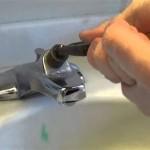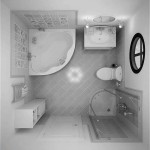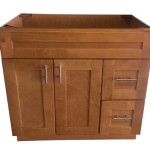How to Remove Dried Paint from a Bathroom Sink
Dried paint on a bathroom sink can mar the appearance of an otherwise clean and functional space. Whether the paint is from a hurried wall touch-up, a clumsy crafting session, or a more extensive renovation, its removal requires a careful approach to avoid damaging the sink's surface. The method chosen will depend on the type of paint, the material of the sink, and the length of time the paint has been dried. This article outlines several effective techniques for removing dried paint, emphasizing safety and preventative measures.
Before initiating any cleanup efforts, identifying the type of paint involved is crucial. Latex paint, commonly used for interior walls, generally proves easier to remove than oil-based paint or epoxy paints, which possess greater adhesion and durability. Knowing the paint type permits selection of the most suitable solvent or removal method, minimizing the risk of scratching or etching the sink's finish. Similarly, understanding the sink's material – whether porcelain, ceramic, stainless steel, acrylic, or another composite – is essential. Certain chemicals or abrasive materials may be safe for one sink material but damaging to another. A preliminary test in an inconspicuous area of the sink is always recommended to ensure compatibility.
Key Point 1: Gentle Methods for Fresh or Water-Soluble Paint
If the paint is relatively fresh or known to be water-soluble (such as latex paint spilled recently), the initial approach should involve gentle methods. These methods aim to soften the paint and lift it from the surface without resorting to harsh chemicals or abrasive tools.
Warm Water and Soap: A simple solution of warm water and dish soap can often dissolve or loosen fresh latex paint. Fill the sink with warm water and add a few drops of dish soap. Allow the painted area to soak for several minutes, then gently scrub with a soft cloth or sponge. Avoid using abrasive scrub pads, as these can scratch the sink's surface. Repeat the soaking and scrubbing process as necessary until the paint begins to lift. This technique is most effective when the paint is still pliable.
Baking Soda Paste: Baking soda acts as a mild abrasive and can help to lift dried paint. Mix baking soda with a small amount of water to create a thick paste. Apply the paste to the painted area and let it sit for approximately 15-20 minutes. Using a soft cloth or sponge, gently scrub the surface in a circular motion. Rinse thoroughly with water and repeat if necessary. Baking soda is less likely to scratch surfaces compared to harsher abrasives, but caution is still advised, especially on delicate sink materials.
Magic Eraser: Melamine foam sponges, commonly known as "magic erasers," are mildly abrasive and can be effective for removing various types of stains and marks, including some types of dried paint. Dampen the magic eraser and gently rub the painted area. Avoid applying excessive pressure, as this can damage the sink's finish. Regularly rinse the sponge to remove any loosened paint particles. While magic erasers are generally safe, it's still recommend to test a small, hidden area first.
Vegetable Oil or Cooking Spray: Certain oils can penetrate and soften dried paint, particularly latex paint. Apply a small amount of vegetable oil or cooking spray to the painted area and let it sit for several hours or overnight. This allows the oil to seep into the paint, loosening its bond with the sink's surface. After soaking, gently scrub with a soft cloth or sponge. Cleanse any residual oil from the sink with soap and water.
Key Point 2: Chemical Solvents for Stubborn Paint
When gentle methods prove ineffective, stronger chemical solvents may be necessary. However, caution must be exercised when using chemical solvents, as they can be harmful to both the user and the sink's surface. Always wear appropriate safety gear, including gloves and eye protection, and ensure adequate ventilation. Read and follow the manufacturer's instructions carefully.
Mineral Spirits: Mineral spirits, also known as paint thinner, are effective for removing oil-based paint. Apply a small amount of mineral spirits to a clean cloth and gently dab the painted area. Allow the solvent to sit for a few minutes, giving it time to soften the paint. Using a clean part of the cloth, gently wipe away the loosened paint. Repeat the process as necessary. After removing the paint, thoroughly clean the sink with soap and water to remove any residual mineral spirits. Use mineral spirits in a well-ventilated area and avoid prolonged skin contact.
Acetone (Nail Polish Remover): Acetone can be effective for dissolving various types of paint, including some acrylic and enamel paints. However, it can also damage certain sink materials, such as acrylic or plastic. Before using acetone, test it in an inconspicuous area to ensure it does not cause discoloration or softening. Apply a small amount of acetone to a cotton ball or clean cloth and gently dab the painted area. Wipe away the softened paint with a clean cloth. Rinse thoroughly with water. Due to its strong solvency, use acetone sparingly and with caution.
Paint Strippers: Commercial paint strippers are designed to remove multiple layers of paint from various surfaces. However, many paint strippers contain harsh chemicals that can damage delicate sink materials. If using a paint stripper, choose one specifically formulated for the type of paint and sink material involved. Always follow the manufacturer's instructions carefully, wearing appropriate safety gear and ensuring adequate ventilation. Apply the stripper to the painted area, allow it to sit for the recommended time, and then carefully scrape away the softened paint with a plastic scraper. Thoroughly rinse the sink with water and neutralize any remaining stripper residue.
Rubbing Alcohol (Isopropyl Alcohol): Isopropyl alcohol can sometimes loosen acrylic paint or paint that has not fully cured. Dampen a cloth or cotton ball with rubbing alcohol and gently dab the dried paint. Let it sit for a few minutes to penetrate the paint. Then, gently wipe or scrub with a soft cloth. Rinse the area with water.
Key Point 3: Physical Removal Methods and Preventative Measures
In some cases, physical removal methods may be necessary, particularly for thick or stubborn paint deposits. However, these methods should be used with extreme caution to avoid scratching or damaging the sink's surface. Furthermore, preventing paint spills and splatters in the first place can significantly reduce the need for aggressive cleaning techniques.
Plastic Scraper: A plastic scraper can be used to gently lift dried paint from the sink's surface. Choose a scraper made from a soft, flexible plastic to minimize the risk of scratching. Hold the scraper at a low angle and carefully work the edge under the paint, gently lifting and peeling it away. Avoid applying excessive force, and periodically clean the scraper blade to remove any paint buildup. This method is most effective for removing thick, flaking paint.
Razor Blade (with extreme caution): A razor blade can be used for very stubborn spots, but only with extreme care and on durable surfaces like porcelain or stainless steel.
Never use a razor blade on acrylic or other soft materials.
Hold the blade at a very shallow angle and gently scrape under the edge of the paint. Use light, controlled strokes. Any misstep could cause serious scratching. This method is best left to experienced individuals and is generally not recommended.The use of heat guns or hair dryers to soften the paint is generally not recommended for bathroom sinks. The heat can potentially damage the sink's finish, particularly on acrylic or composite sinks, and may pose a fire hazard.
Preventative Measures: The best way to deal with dried paint on a bathroom sink is to prevent it from happening in the first place. Before any painting or crafting project, cover the sink with a drop cloth or plastic sheeting. Immediately wipe up any spills or splatters with a damp cloth before they have a chance to dry. When cleaning paint brushes or tools, use a separate container or utility sink instead of the bathroom sink. By taking these simple precautions, one can significantly reduce the risk of paint stains and the need for aggressive removal techniques. Ensure proper ventilation during painting projects to minimize fumes and promote quicker drying times, reducing unintended splatter. Carefully control painting tools to prevent drips and splashes.
After successfully removing the dried paint, thoroughly clean the sink with a mild soap and water solution. Inspect the surface for any scratches or damage. If necessary, use a porcelain or stainless steel cleaner to restore the sink's shine. Regular cleaning and maintenance will help to keep the sink looking its best and prevent future stains from becoming permanent. Addressing spills and splatters promptly is always easier than dealing with dried and hardened paint.

3 Easy Ways To Get Dry Paint Off Your Bathroom Sink Homes On Point
How To Remove Vanity Paint Splatters

Paint Care Cleanup Purdy

How To Clean A Stained Utility Sink Within The Grove

How To Clean A Stained Utility Sink Within The Grove

How To Paint A Sink It All Started With

Paint Bathroom Vanity Countertop Sink So Easy A Piece Of Rainbow

How To Paint A Sink It All Started With

How To Paint A Sink Diy Bathroom Project Your Budget Will Love

Transform Your Bathroom With Sink Paint The Honeycomb Home
Related Posts







